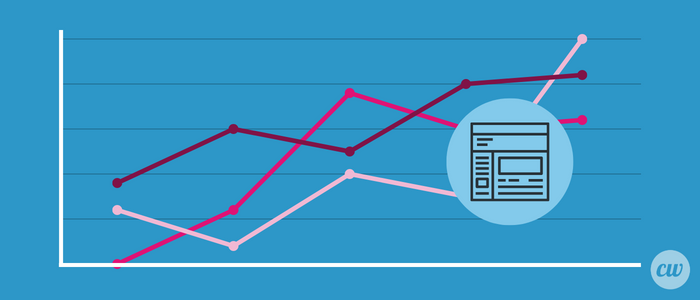
How to Measure the Value of Content Marketing
Measuring the value and overall return on investment (ROI) of content marketing has been a central topic of discussion in the digital marketing space for decades. Content marketing ROI feels hard to pin down, which is why smart brands monitor ROI with tools and continue to invest in content marketing.
Content marketing ROI also relies on ensuring you’re selecting the right metrics, and that all stakeholders have agreed upon the value associated with those goals. For example, if you’re marketing a recruiting event with a landing page, you could aim for and track a few separate metrics:
- How many people clicked on a post to your event landing page
- Number of visitors to the landing page registered for the event
- Total visitors who went to the landing page and sent in their resume
- The number of people who clicked through to the landing page then browsed the careers page and applied for a job
You’ll also need to know the importance and value of the action you want them to do. While this is usually a product or service with a dollar value, in the example of a recruiting event, it’s the value of acquiring a new employee. In this example, some organizations might not have that value.
Therefore, you’ll have to get creative: how much does it cost them to acquire an employee by other methods? (You could use the ADP-calculated average of $4,129 if no one can tell you.) How much does an employee get for referring a successful candidate to the organization?
As demonstrated, establishing the necessary metrics is essential to determining the ROI of the campaign. You need to know the acquisition value of the target. You also need to identify the target before getting started. Too often we’re told to “quickly market something,” but in reality, a successful campaign involves identifying and tracking these metrics.
If you’re a marketer, you get this: we’ll be asked to do something quickly, and once the campaign is done, we’re asked to show our value. It can even feel like we’re being asked to justify our jobs and value – and in a way, we are!
What Is Content Marketing, Exactly?
To properly calculate content marketing ROI efforts and strategize around maximum ROI, it’s crucial to understand the definition of content marketing. You should know which efforts in your strategy fall into the domain of content marketing.
Marketers struggle with defining it because content marketing can encompass a long-term strategy. Even if you’re marketing a one-time event, you’re likely planning your campaign, creating content, and scheduling posts months or even years in advance of the single event itself.
Defining content marketing for your strategy means it should include the following elements:
- It consists of multiple pieces of content
- You have a way of measuring the success of the content
- Your target audience is clearly defined
- Your goal involves driving profit or creating a specific outcome, such as an email list signup, which creates profit down the road
As you can see with the email marketing example, content marketing and proving its ROI can get complex. That’s because some of the most successful marketing actions – like convincing people to sign up for your email list – don’t result in immediate sales, even though they provide value. Because of this, you want to make sure you identify and measure your conversion for each piece of content.
A marketing conversion is not necessarily a sale, but a point of success and the goal of your content. You might want your conversion to be an email list signup. This is a standard success metric because once they sign up and get personalized and/or even automated chains of emails, they’ll be more likely to buy over time with email marketing.
Email marketing has a much higher sales conversion rate than most blog posts. People won’t sign up for that email list unless they’re drawn in by another type of content such as a percentage off or a compelling piece of helpful content that they found organically.
How Is Content Marketing Value Calculated?
To calculate the value of the content, you will need to know and outline the parameters for:
- What defines a conversion (this could include one or more targets)
- The value of a conversion
- The cost of creating content (for example, hiring a writer to create the content)
- How much money you’ve spent on paid advertising
- The length of your campaign AND the longevity of campaign measurement (evergreen content proves its value more over time)
There are a lot of marketing blogs and formulas out there to help you determine content marketing ROI, but you should also consider the standard business formula, which can help you display and calculate the success of your efforts. Standard ROI formulas ask you to consider the types of revenues and costs you incur with the “opportunity,” or in our case, a marketing campaign.
Revenue prediction:
- Direct revenue earned
- Indirect revenue earned
- Residual revenue earned
Expenses prediction:
- Direct costs incurred
- Indirect costs incurred
- Opportunity costs if you ignore your opportunity efforts
When you’ve completed this, subtract your expenses from your revenue. As indicated, you can do this as a prediction to decide whether a campaign is worth running. You can and should also do this following the end of a campaign to measure your success in a way that leadership and C-suite executives understand.
This also provides a solid number to present in a slideshow or another type of dashboard format. If you’re successful, you can make a statement by simply writing your number on the whiteboard or in your Zoom chat to begin the conversation.

How to Measure Content Marketing ROI
The above formula covers how to measure and analyze your ROI, but many marketers make a crucial mistake with their content marketing ROI: they only think about money. This is where it gets tricky because we all know that branding is incredibly valuable, but it’s hard to measure the value. The goal of many marketing campaigns is to contribute to branding efforts.
If you’re a small brand with a limited marketing budget, your CEO isn’t going to end up hearing your latest slogan on the street, but there are other metrics you can use to prove the value of ROI.
Brand Awareness
This involves using and measuring Search Engine Optimization (SEO) that strengthens your brand, even if it doesn’t directly relate to your marketing campaign or the product or service you’re selling. So if you’re selling party planning services but your marketing campaign is geared towards getting people to sign up for a free webinar, your primary conversion would be the webinar signup – but, don’t discount the value of your content if it brings in organic traffic about general party planning services. This is especially true if Google Analytics reveals it resulted in a sales inquiry!
Brand Loyalty
Capture metrics about return or repeat customers. It takes a while for some products and services to convert, especially if they cost a fair amount, so there’s real value in winning repeat visits and repeat business. Loyal customers may also mention you positively on social media. Mentions are another metric you can measure by using a social media tool to monitor when they happen.
Best Types of Content for Content Marketing ROI

Always establish your ROI baseline and measure against that. ROI can vary considerably by industry, list size, company size, budget, and the type of product or service you are offering.
The best type of digital marketing for ROI is by far email marketing. It can have an ROI of up to 675 percent. While that’s not a typical result, email marketing is widely regarded as the safest type of content for ROI – but it only works if you have an email list. To build that list, you’ll need other types of content to encourage sign-ups, such as blogs, good website copy that ranks, standout social media posts, pay per click (PPC) ads, and more.
A blog, free webinar, or even a post in your own Facebook group can generate those email sign-ups, direct conversions, and other eventual sources of ROI. Your blogs shouldn’t only be tied to sales and revenue when it comes to success. Consider subscriptions and long-term lead-gen, and the engagement and reach of the content.
This is where the soul of marketing comes into play. Did the content feel personal to your audience in some way? Did it resonate? Did it hit the right person at the right time in their lives? Did you post about it at the time of day they were most likely to see it? There’s a lot that goes into ensuring the success of your content.
Don’t forget the value of community management and content curation, either. We often forget about the value of these crucial marketing components because it costs time and money to post regularly and manage those communities. The posting results in keeping customers and community members around so you can surround your brand with a supportive community and cultivate it to self-perpetuate a positive experience for those interested in your brand.
Lastly: remember that content marketing changes with time, and you need to stay up on the latest trends. This will reveal what customers value (as long as successful brands are willing to prove their ROI.)
Increase Content Marketing ROI With Expert Writers
No matter what you choose as your ROI target, or how complex your ROI calculation is, content is a necessary part of your progress. Determine your target, measure your success, prove your value, and display it in an easy-to-comprehend dashboard format.
Get on target today with well-written content by vetted writers at ContentWriters.com. Our services allow you to evaluate existing content, plan new pieces and support marketing campaigns, and measurably increase your marketing ROI.
Tara lives outside of Washington, D.C and is a storyteller. From marketing to serial fiction, guided meditation, and character-driven self-discovery experiences, she’s been writing and editing for decades.




